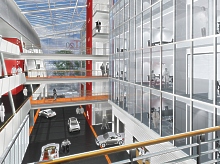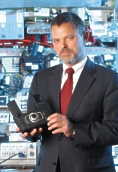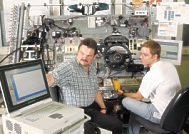
. . .
.. . . . Related Topics
© 1998 - 2004
Copyright & |
Audi : Audi Electronic Center
The number of electronic devices in vehicles is constantly increasing: navigation systems, on-board computers, infotainment systems, electronic engine management and transmission control, airbags, ABS, ESP, electric window lifts and central locking systems - modern cars cannot operate without electronics. Numerous in-car electronic control devices communicate with each other. Audi models have been driving the data highway for quite some time.
Here is just one example of the unstoppable progression of software integration in cars: The current Audi A8 can store up to three megabytes of data, but this figure will rise to 90 megabytes in the next A8, and Dr. Schleuter adds: "From 1990 to 2005, the specific computing capacity in cars will have multiplied by ten million." This is an incredible figure. "And according to Dr. Schleuter, this is what the great challenge is about: "Making the ever more complex electronic networks in the vehicle easy to operate for the customer and the processes reliable." His credo is: "With electronics, you have to concentrate on simplicity and customer orientation." Another important factor is how to combine extremely dynamic development progress in the field of electronics with the comparatively long lifecycle of a car. The future Electronic Centre, which will combine all Audi's electronic capabilities under one roof, is destined to play a decisive part in this strategy. At present, the individual specialist departments are scattered over the entire Technical Development area in Ingolstadt.
"We aim to focus on teamwork," declares Rolf Driessen, the Electronic Centre product manager. The respective project teams will communicate between divisions and by way of short paths - basically across the desktop. For Dr. Schleuter, innovative electronics development involves organisational changes, flat hierarchies, efficient processes and a young and motivated team; he calls this "inter-divisional networking of people and tasks". Flexibility is another important goal, according to project manager Driessen. Project teams from different areas can move closer together geographically for different activities without major reconstruction work. This is particularly important in the electronics area, where experts from the most varied fields may work together on a project for a limited period of time. All this will be aided by a "transparent, open" architectural concept: A seven-storey office building forms the front of the complex. From there, the roof goes down sharply and a four-storey atrium with glass at the sides and in the roof connects the office area with the second building complex. Says Driessen, "Bridges and walkways link the two architectural bodies in this atrium, which is flooded with light. The enable you to walk the short distance from your desk to the workshop and laboratory sector." The renowned RKW Architektur + Städtebau office based in Düsseldorf, chosen in preference to other submissions in an architectural competition, is responsible for realising the concept. Apart from its architectural design, the Electronic Centre will feature ultra-modern measuring and testing equipment. Among other things, a climatic roller test rig for function and reliability testing of electronic components in the most extreme temperatures and various road conditions will be installed. The combined test rig system can simulate arctic cold as well as tropical heat or extremely hot desert climates. The Electronic Centre will also feature an MMI laboratory exclusively for testing and improving all the functions controlled by Audi's innovative Multi Media Interface (MMI) control concept, under real-world conditions. In a state-of-the-art sound laboratory, acoustics specialists will not only work on Audi's car audio systems but also develop complete concepts of how an Audi is supposed to sound. The 50-metre long, ten-metre wide light tunnel in the basement for developing new lighting systems will be another highlight. At present, Audi's engineers test lighting innovations on the company's own test track in Neustadt and elsewhere. This of course can only be done if it is dark outside. Audi already has a leading position among car manufacturers as far as electronics development is concerned. The Audi A8's successor to be introduced later this year will set new standards in terms of chips, bits and bytes. With the new competence centre, this top position is to be strengthened and expanded. (Ingolstadt, May 2002) Pictures source: Audi AG
|




 Avantissimo
Avantissimo









